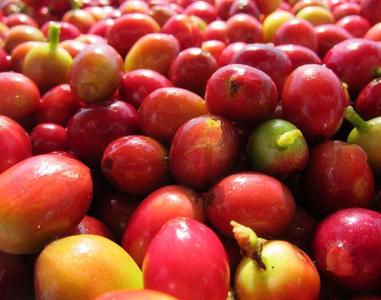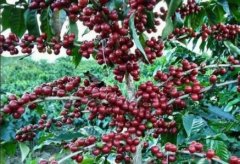A brief introduction to the planting Market Price of Diamond Hill Fine Coffee beans in Costa Rica with bitter Chocolate

Tarrazu, Costa Rica, is one of the world's leading coffee producers, producing coffee with a light, pure flavor and pleasant aroma. Costa Rica's volcanic soils are fertile and well drained, making it the first country in Central America to grow coffee and bananas for commercial value. Coffee and bananas are the country's main exports. Coffee was introduced to Costa Rica from Cuba in 1729, and today its coffee industry is one of the most well-organized in the world, producing up to 1700 kilograms per hectare. Costa Rica has a population of 3.5 million, but coffee trees number 400 million, and coffee exports account for 25% of the country's total exports. Costa Rica also benefited from the Central American Agricultural Research Institute, established in Tarazu
Other types of Brazilian coffee, such as Rio, Parana, etc., can be produced in large quantities without too much care. Although the taste is rough, it is a kind of inexpensive coffee. Due to its distribution in all parts of the country, the solid quality varies, and there are its own standards (NO.2~NO.8 according to the number of impurities, NO.13~NO.19 according to the size of beans, divided into six grades according to taste). Almost all Arabica varieties are of good quality and stable prices, the most famous being Costa Rica, which has been a necessity for blended coffee since ancient times and is familiar to the public.
Excellent Costa Rican coffee is known as "extra hard beans" and can grow at altitudes above 1500 meters. Altitude has always been a problem for coffee growers.
The higher the altitude, the better the beans, not only because higher altitudes increase the acidity of the beans and thus enhance the flavor, but also because the lower night temperatures at higher altitudes can slow down the growth of trees and thus enhance the flavor of the beans. In addition, due to the high altitude drop caused by sufficient rainfall, coffee tree growth is very favorable. The negative effect, however, is to increase the additional cost of transportation, which may well make coffee production unprofitable. Costa rican coffee has adopted new techniques to increase efficiency, including the use of "electric eyes" to select beans and identify beans of irregular size. Premium costa rican coffee, known as "extra hard beans," can grow at altitudes of more than 1500 meters. Altitude has always been a problem for coffee growers. Coffee beans are better at higher altitudes, not only because higher altitudes increase the acidity of coffee beans and thus enhance flavor, but also because lower night temperatures at higher altitudes cause trees to grow slowly, thus making coffee beans more flavorful. In addition, due to the high altitude drop caused by sufficient rainfall, the growth of coffee trees is also very favorable.
However, while there are many advantages to growing coffee at higher altitudes, the additional transportation costs associated with it must be taken into account, which may well make coffee production unprofitable. Costa Rican coffee has adopted new techniques to increase efficiency, including the use of "electric eyes" to select beans and identify beans of irregular size
Coffee farming is a relatively advanced occupation in Costa Rica. Coffee farmers have a high status in Costa Rica. In 1897, the citizens of the capital witnessed the inauguration of the National Theatre donated by the coffee tycoon. Coffee wealth has brought stability to Costa Rica's politics, economy and democracy, something rare in Central America. In addition, Colombia has laws that allow only Arabica to be grown, and Robasta is a "contraband" in its territory, and it is also the first in the world.
Costa Rica's output is not large, with an annual output of about 110,000 tons, ranking seventh in Central and South America. Colombia is dominated by recent coffee varieties, such as kadura, kaduai, new world, etc., ancient bourbon and tibeka are rare. There are also many varieties derived from the territory, the most famous is Bourbon variety Vera Saqi, belonging to the elegant flavor of varieties, Brazil has also been introduced to plant, has won awards. In addition, Colombian research institutions have spared no effort to improve the hybrid Katimo, trying to reduce the strong bean bloodline and enhance the Arabica flavor of Katimo, which has been exported to Asia for trial cultivation in recent years.
Costa Rican coffee is full of particles, with ideal acidity and unique aroma. Costa Rica's coffee industry, formerly controlled by the Instituto del Café de Costa Rica (ICAFE), has been taken over by the Official Coffee Council (Oficin del Café). Among coffee exports, those deemed substandard are colored with blue vegetable dye before being recycled for domestic sale. Coffee consumed domestically (dyed blue or undyed) accounts for about 10% of the total production, and local coffee consumption per capita is twice that of Italy or the United States. Costa Rica's coffee is all Arabica beans. It is washed and its style is bright, full of aroma, clear as wind chimes in the breeze, and mild acid. Sweet. Because of the sweet taste, even if the coffee is cold, it is also very good to drink, which is a major feature of Costa Rica coffee. Therefore, it is recommended that you taste Costa Rican coffee with only a small amount of sugar and creamer to enjoy its girlish and pure flavor. Other coffees worth mentioning are Juan Vinas (PR), H.Tournon, Windmill (SHB), Montebello and Santa Rosa. Fine coffee is grown in Geredia and the Central Valley. Another striking coffee is Sarchi (one of five towns that represent Costa Rica's "coffee route"), which grows on the slopes of Poas Volcano, 53 kilometers from San Jose. Saatchi was founded in 1949 and has 30770 hectares of land to grow sugar cane and coffee. The area is also known for its handicrafts, attracting tourists from all over the world.
Important Notice :
前街咖啡 FrontStreet Coffee has moved to new addredd:
FrontStreet Coffee Address: 315,Donghua East Road,GuangZhou
Tel:020 38364473
- Prev

A brief introduction to the origin, development, history and culture of Costa Rican Diamond Mountain boutique coffee beans.
Other kinds of Brazilian coffee, such as Rio and Parana, can be produced in large quantities because they do not need too much care. Although the taste is rough, it is a kind of good and cheap coffee. It has its own standard because it is distributed all over the country and its solid quality varies. It has its own standard (NO.2~NO.8 according to the number of sundries, NO.13~NO.19 according to the size of beans, and six grades according to taste).
- Next

Taste mellow Costa Rica Diamond Hill boutique coffee beans cultivation geographical location climate altitude
Because of the sweetness, even if the coffee gets cold, it tastes very good, which is a major feature of Costa Rican coffee. Therefore, it is recommended that when you taste Costa Rican coffee, you should only add a small amount of sugar and cream, so that you can enjoy its girlish flavor. Other coffee worth mentioning are: JuanVinas,PR, H.Tournon, Weide.
Related
- Detailed explanation of Jadeite planting Land in Panamanian Jadeite Manor introduction to the grading system of Jadeite competitive bidding, Red bid, Green bid and Rose Summer
- Story of Coffee planting in Brenka region of Costa Rica Stonehenge Manor anaerobic heavy honey treatment of flavor mouth
- What's on the barrel of Blue Mountain Coffee beans?
- Can American coffee also pull flowers? How to use hot American style to pull out a good-looking pattern?
- Can you make a cold extract with coffee beans? What is the right proportion for cold-extracted coffee formula?
- Indonesian PWN Gold Mandrine Coffee Origin Features Flavor How to Chong? Mandolin coffee is American.
- A brief introduction to the flavor characteristics of Brazilian yellow bourbon coffee beans
- What is the effect of different water quality on the flavor of cold-extracted coffee? What kind of water is best for brewing coffee?
- Why do you think of Rose Summer whenever you mention Panamanian coffee?
- Introduction to the characteristics of authentic blue mountain coffee bean producing areas? What is the CIB Coffee Authority in Jamaica?

